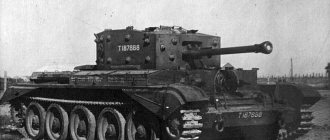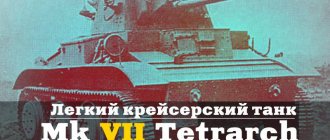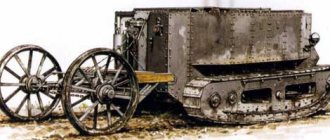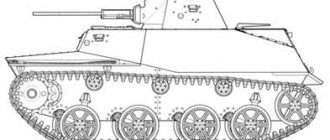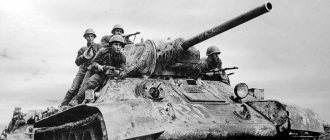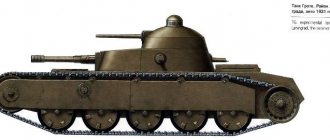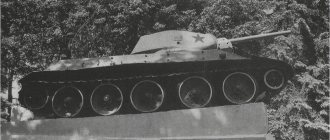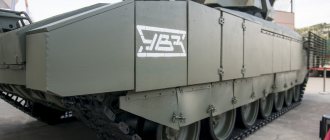Cruiser tanks
Cruiser tanks
Cruiser Tank Mark I (A9)
Developed by Vickers since 1934 and initially considered as a medium tank. After the transition to dividing tanks into infantry and cruiser tanks, it was reclassified into the Mk I cruiser tank. The only original part of the project was the suspension, later used on the Valentine infantry tank. Also, for the first time in British tank building, a hydraulic turret rotation drive was used. In 1937, Vickers and Harland and Wolff produced 125 units.
Serial modifications:
Mk I - the basic model, armed with a 2-pounder gun in the main turret and two water-cooled Vickers machine guns in two small turrets.
Mk ICS - “assault” version (CS - Close Support), armed with a 3.7-inch (94 mm) howitzer.
The Mk I saw action in France in 1940 as part of the 1st Panzer Division and all were left behind at Dunkirk. The 2nd and 7th Tank Divisions in Egypt used the remaining Mk Is until 1941, after which these hopelessly outdated tanks were scrapped for metal. Attempts to use tank chassis for other purposes were unsuccessful.
Mk I
TACTICAL AND TECHNICAL CHARACTERISTICS OF THE CRUISING TANK Mark I
COMBAT WEIGHT, t: 13,042. CREW, people: 6.
OVERALL DIMENSIONS, mm: length—5791, width—2502, height—2654.
ARMAMENT: 1 Mk IX cannon 2 pound caliber, 3 Vickers machine guns 7.7 mm caliber.
AMMUNITION: 100 rounds, 3000 rounds.
RESERVATION, mm: 6 - 14. ENGINE: AES Tour 179, 6-cylinder, in-line, carburetor, liquid cooling, power 150 hp. (110 kW), working volume 9500 cm?.
CHASSIS: six rubber-coated road wheels on board, rear drive wheel (pinion engagement, in the middle of the track), blocked suspension, balanced with a spiral spring spring and a hydraulic shock absorber; three rubberized support rollers; track width 315 mm.
MAX. SPEED, km/h: 40.
COURSE RESERVE, km: 241.
OBSTACLES TO OVERCOME: wall height, m - 0.92, ditch width, m - 2.43.
COMMUNICATIONS: radio station No. 9 or No. 19.
Cruiser Tank Mark II (A10)
Project A10 was a developed version of the A9 tank, but is usually designated as a "heavy cruiser". Adopted by the British army under the designation Mk II. Until 1940, Vickers, BRCW and Metro produced 175 tanks of all modifications.
Serial modifications:
Mk II - visually differed from the cruising tank Mk I in the absence of two machine-gun turrets in the frontal part of the hull. Instead, one air-cooled BESA machine gun was installed. 13 units produced.
Mk IIA is an improved cannon mount compared to Mk I and Mk II.
Mk IICS - variant with a 94 mm howitzer. About 30 units were produced.
These tanks took part in combat operations in France and Libya. Their armor turned out to be too weak, but still they proved themselves better than the completely unsuitable Mk I.
Mk II
TACTICAL AND TECHNICAL CHARACTERISTICS OF THE CRUISING TANK Mark II
COMBAT WEIGHT, t: 14.39.
CREW, people: 5.
OVERALL DIMENSIONS, mm: length - 5588, width - 2527, height - 2654.
ARMAMENT: 1 Mk IX cannon, 2 pound caliber, 2 machine guns, 7.92 or 7.7 mm caliber.
AMMUNITION: 100 rounds, 4050 rounds.
RESERVATION, mm: 6 - 30.
ENGINE: AES Tour 179, 6-cylinder, in-line, carburetor, liquid cooling, power 150 hp. (110 kW); working volume 9500 cm?.
CHASSIS: six rubber-coated road wheels on board, a rear drive wheel (lantern engagement in the middle of the track), blocked balancer suspension, with a spiral spring spring and a hydraulic shock absorber; three rubberized support rollers; track width 355 mm.
MAX. SPEED, km/h: 26.
POWER RESERVE, km: 161.
OBSTACLES TO OVERCOME: wall height, m - 0.92, ditch width, m - 2.43.
COMMUNICATIONS: radio station No. 9 or No. 19.
Cruiser Tank Mark III (A13)
An important stage in British tank building is associated with this tank. After the British military attaches visited the Kyiv maneuvers. where they saw hundreds of BT type tanks, the British military department in 1936 purchased one tank of his type from designer Christie. On its basis, the development of the A13 cruising tank began with the chassis and suspension borrowed from the American prototype. When creating the A13 and during testing, the British encountered great difficulties, which were never overcome with this model.
In 1937, Nuffield built the A13 prototype and then produced 65 tanks of this type.
Serial modification:
Mk III is the only production version. Chassis and suspension are Christie type. The turret is riveted, rectangular in shape with a commander's cupola and a small aft niche. The layout of the tank is classic.
Cruiser tanks Mk III took part in battles in France in 1940. Several vehicles of this type were available in the 7th Panzer Division in North Africa.
Extremely low operational reliability and weak armor reduced the combat capabilities of this tank to almost zero.
Mk III
TACTICAL AND TECHNICAL CHARACTERISTICS OF THE CRUISING TANK Mark III COMBAT WEIGHT, t: 14,237.
CREW, people: 4.
OVERALL DIMENSIONS, mm: length - 6020, width - 2540, height -2591.
ARMAMENT: 1 Mk IX cannon 2 pound caliber, 1 Vickers machine gun 7.7 mm caliber, 2 smoke grenade launchers 101.6 mm caliber. AMMUNITION: 87 rounds, 3750 rounds.
RESERVATION, mm: 6 - 14.
ENGINE: Nuffield - Liberty, 12-cylinder, V-shaped, carburetor; power 340 hp (250 kW).
TRANSMISSION: planetary gearbox and final drives.
CHASSIS: four large-diameter rubber-coated road wheels on board, a rear-mounted drive wheel (lantern engagement), individual suspension, on cylindrical spring springs, track width - 257 mm.
MAX. SPEED, km/h: 50.
POWER RESERVE, km: 149.
OBSTACLES TO OVERCOME: ascent angle, degrees. -30, wall height, m - 0.61 ditch width, m -2.29.
COMMUNICATIONS: radio station No. 19.
Cruiser Tank Mark IV (A13 Mk II)
Further development of the cruiser tank Mk III (A13). Developed by Nuffield (according to other sources Morris Motors) in 1938. Serial production was carried out from December 1938 to the end of 1939 by Nuffield, English Electric, LMS and Leyland. 655 units produced.
Serial modifications:
Mk IV - both externally and internally is almost identical to the A13 tank. The turret has a new shape due to the use of inclined side sheets of additional armor. The armor protection was strengthened, but the internal volume of the turret remained unchanged. The power plant is also similar to the A13 - an American Liberty aircraft engine from the First World War, throttled to 340 hp. Armament is a 2-pounder cannon and a water-cooled Vickers machine gun. Crew 4 people.
Mk IVA - instead of the Vickers machine gun, a 7.92 mm air-cooled BESA machine gun is installed.
Mk IVCS is an infantry support tank armed with a 94 mm howitzer.
Mk IV
Tanks of the Mk IV series formed the basis of the fleet of British tank formations on the eve and at the beginning of the 2nd World War. They took part in the battles in France in 1940 as part of the 1st Panzer Division. The ranks of the 7th Panzer Division fought in North Africa until 1942, when they were finally withdrawn from service.
The Mk IV turned out to be a significantly more combat-ready vehicle than its predecessors, but its operational reliability also left much to be desired.
TACTICAL AND TECHNICAL CHARACTERISTICS OF THE CRUISING TANK Mark IVA
COMBAT WEIGHT, t: 14,987.
CREW, people: 4.
OVERALL DIMENSIONS, mm: length - 6020, width - 2540, height - 2591.
ARMAMENT: 1 x 2 lb cannon, 1 x BESA 7.92mm machine gun.
AMMUNITION: 87 rounds, 3750 rounds.
RESERVATION, mm: 6 - 38.
ENGINE: Nuffield - Liberty, 12-cylinder, V-shaped, carburetor, liquid cooling, power 340 hp. (250 kW). TRANSMISSION: planetary gearbox and final drives.
CHASSIS: four large-diameter rubber-coated road wheels per side, rear drive wheel (lantern engagement); individual suspension, on cylindrical spring springs; Track track width is 257 mm.
MAX. SPEED, km/h: 48.
POWER RESERVE, km: 149.
OBSTACLES TO OVERCOME: ascent angle, degrees. - 30, wall height, m - 0.61, ditch width, m - 2.29.
COMMUNICATIONS: radio station No. 9 or No. 19.
Cruiser Tank Mark V (A13 Mk III) Covenanter
A logical continuation of the design of the A13 and A13 Mk II tanks. Work on the A14 and A16 projects was interrupted in 1939 in favor of the A13 Mk 111, which was a redesigned A13 project with a lower silhouette and 30 mm armor. The reduction in body height was achieved, in particular, through the use of a horizontally opposed engine and the use of a new type of radiators.
Since 1939, LMS has manufactured 1,771 tanks.
Serial modifications:
— there were four modifications (from Covenanter I to Covenanter IV), which differed from each other only by minor changes in the cooling system. In appearance (Christie-type chassis, squat hull, riveted turret with beveled walls and a wide landing hatch in the rear) they were almost identical. Their weapons were no different, with the exception of the CS variant with a 94 mm howitzer.
Despite the partial solution of technical problems and further improvement of the design, the Mk V did not become an operational first-line tank and was used mainly for training purposes. A number of tanks were converted into bridge laying vehicles, command and control vehicles and armored vehicles.
Covenanter
TACTICAL AND TECHNICAL CHARACTERISTICS OF THE CRUISING TANK Mark V Covenanter
COMBAT WEIGHT, t: 18,305.
CREW, people: 4.
OVERALL DIMENSIONS, mm: length - 5801, width - 2610, height - 229.
RESERVATION, mm: hull front - 16, side and stern - 14, roof and bottom - 7; tower - 9 - 39.
ARMAMENT: 1 x 2 lb cannon, 1 x BESA 7.92mm machine gun. The tank could be equipped with a 7.7 mm Bren anti-aircraft machine gun.
ENGINE: Meadows DAV, 12-cylinder, horizontally opposed, carbureted; power 280 hp (206 kW), working volume 16,204 cm?.
TRANSMISSION: double-disc main clutch, four-speed gearbox, planetary steering mechanism, final drives.
CHASSIS: four large-diameter rubber-coated road wheels per side, rear drive wheel (lantern engagement); individual suspension, on cylindrical spring springs; Track track width is 273 mm.
MAX. SPEED, km/h: 50.
POWER RESERVE, km: 161.
COMMUNICATIONS: radio station No. 19.
Cruiser Tank Mark VI (A15) Crusader
The Crusader cruising tank was created simultaneously with the Covenanter, according to a similar technical specification, but by Nuffield. His project was a development of the A13 design, and the tank was initially intended to be used as a heavy reconnaissance vehicle. In fact, it had to become the most popular British tank during the African campaign.
Between 1939 and 1943, nine Nuffield factories produced 5,300 Crusader tanks.
Serial modifications:
Crusader I - the first production version. Unlike previous cruising tanks, the chassis had not four, but five road wheels. Liberty engine, turret identical to the turret of the A13 tank. A characteristic feature of this modification is the presence of a turret with a BESA machine gun in the frontal part of the hull to the left of the driver. Combat weight 19.279 tons, armor 7-40 mm. Crew 5 people.
Crusader ICS is an infantry escort tank with a 94 mm howitzer.
Crusader II - no significant changes compared to Crusader I, with the exception of slightly increased armor thickness and the absence of a machine gun turret on most tanks. For tanks of the previous model, it was often dismantled by the troops. Depending on the presence or absence of a turret, the crew ranged from 4 to 5 people.
Crusader IICS - 94mm howitzer instead of a 2-pounder gun.
Crusader III - instead of a 2-pounder, a 6-pounder gun is installed. The armor thickness has been increased to 51 mm. Combat weight 20.04 tons.
Combat use of Crusader tanks began in June 1941 during Operation VaSheahe in North Africa as part of the 7th Tank Brigade of the 7th Tank Division. They arrived in Egypt on Churchill's orders so that British troops could begin military operations against Rommel with the latest tanks. Already during the first battles, the “crusaders” suffered severe losses from the fire of 88-mm German anti-aircraft guns.
The Crusaders of the first and second models were not a very serious opponent for German medium tanks due to their not very powerful weapons and insufficient armor protection. To some extent, these shortcomings were eliminated on the Crusader III. At the same time, its weak point was still its low technical reliability.
Since the beginning of 1942, only two squadrons in British tank regiments have retained Crusader tanks in service. In the third, they were replaced by the American General Grant, armed with a 75-mm cannon.
After the end of hostilities in North Africa, the Crusaders were removed from service. Only a small number of these vehicles took part in operations in Italy.
On the basis of the Crusader tank, self-propelled guns, command tanks, forward artillery observer vehicles, armored vehicles, artillery tractors and bulldozers were produced (or converted from linear tanks).
Crusader II
Crusader III
TACTICAL AND TECHNICAL CHARACTERISTICS OF THE CRUISING TANK Mark VI Crusader II
COMBAT WEIGHT, t: 19,279.
CREW, people: 5.
OVERALL DIMENSIONS, mm: length - 5994, width - 2642, height - 2235, ground clearance - 406.
RESERVATION, mm: 7 -49.
ARMAMENT: 1 x 2 lb (40 mm) cannon, 2 x 7.92 mm BESA machine guns, 7.7 mm Bren anti-aircraft machine gun.
AMMUNITION: 130 rounds, 5000 rounds of 7.92 mm caliber.
ENGINE: Nuffield—Liberty, 12-cylinder, V-shaped, carburetor, liquid cooling; power 340 hp (250 kW) at 1550 rpm; working volume 27,045 cm?.
TRANSMISSION: multi-disc main clutch, four-speed gearbox, planetary steering mechanism, final drives.
CHASSIS: five large-diameter road wheels per side, rear drive wheel (pinion engagement), individual suspension, on cylindrical spring springs, track width - 273 mm.
MAX. SPEED, km/h: 43.
POWER RESERVE, km: 255.
OBSTACLES TO OVERCOME: ascent angle, degrees. - 30, - wall height, m - 0.69, ditch width, m - 2.59.
COMMUNICATIONS: radio station No. 19.
Cruiser Tank Mark VII (A24) Cavalier
In June 1941, development began on a heavy cruiser tank more powerful than the Crusader. This tank was named Cromwell. However, due to the lack of Rolls-Royce “Meteor” engines intended for it (they all went into aviation), it was decided to install the old Liberty aircraft engine on the new tank, as on previous models of cruising tanks. The tank was named Cavalier and indexed A24.
Cavalier
From the summer of 1942 to the spring of 1943, 500 tanks of this type were manufactured at the Nuffield plant in Birmingham.
Serial modification:
- the rectangular hull and turret without any rational angles of inclination were assembled on frames made of rolled armor plates using bolted connections. The armament consisted of a 6-pounder cannon and a coaxial machine gun; another machine gun was installed in the front plate of the hull to the left of the driver. The chassis had five road wheels.
Due to its greater mass, the Cavalier had worse dynamic characteristics than the Crusader. Operating under overvoltage, the already unreliable Liberty engines continually failed. For this reason, the “Cavaliers” were not included in combat units, but were used only for training purposes.
In the second half of 1943, about 200 tanks were converted into control vehicles for artillery units of tank divisions. They took part in the fighting on the Western Front in 1944 - 1945. A small part of the tanks were converted into ARVs.
TACTICAL AND TECHNICAL CHARACTERISTICS OF THE CRUISING TANK Mark VII Cavalier
COMBAT WEIGHT, t: 26,949.
CREW, people: 5.
OVERALL DIMENSIONS, mm: length - 6350, width - 2883, height - 2438, ground clearance - 406.
RESERVATION, mm: 20 - 76.
ARMAMENT: 1 6-pound cannon, 2 WEBA machine guns 7.92 mm.
AMMUNITION: 64 rounds, 4950 rounds.
ENGINE: Nuffield—Liberty, 12-cylinder, V-shaped, carburetor, liquid cooling, power 340 hp. (250 kW) at 1500 rpm, displacement 27,045 cm?.
TRANSMISSION: multi-disc dry friction main clutch, 4-speed planetary gearbox. CHASSIS: five large-diameter road wheels per side, rear drive wheel (pinion gear), individual suspension, on cylindrical spring springs, track width - 356 mm. MAX. SPEED, km/h: 39.
POWER RESERVE, km: 265.
OBSTACLES TO OVERCOME: wall height, m - 0.9, ditch width, m - 2.3, ford depth, m - 0.9.
COMMUNICATIONS: radio station No. 19.
Cruiser Tank Mark VIII (A27L) Centaur
In 1941, it was decided to develop, along with the A27 tank, equipped with the Meteor engine, which was in short supply at that time, a so-called intermediate version with the Liberty engine, which was produced in large quantities. The latter could be used in conjunction with the new Merritt-Brown transmission, which replaced the old Wilson-type planetary transmission, which was used on British tanks during the 1st World War.
The tank project was developed by English Electric, and it was named A27L (L-Liberty). The version with the Meteor engine was designated A27M.
Several firms were involved in the production of the Centaur: Leyland, LMS, Harland, Fowler, English Electric and Nuffield. In total, from August 1942 to February 1944, 3134 Centaur of all modifications (including self-propelled guns) were produced. Thus, this tank, less famous than the Cromwell, became the most popular “heavy cruiser” of the British army in the 2nd World War.
Serial modifications:
The Centaur I was the first tank variant to be armed with a 6-pounder cannon.
Centaur III - 75 mm Mk V or Mk VA gun. A significant part of the vehicles of this modification were obtained by conversion from Centaur I.
Centaur IV is a support tank armed with a 95mm howitzer. The howitzer fired high-explosive fragmentation and smoke shells. Initial speed 328 m/s. Ammunition 51 shots. The tank's combat weight is 28.874 tons.
From the end of 1943, when production of Meteor engines and 75-mm guns was launched, mass conversion of the Sentores to the Cromwell standard began. It was possible to distinguish these tanks from each other only by minor details. For example, the mechanism for tensioning the tracks was different.
"Sentors", in which the engines were not replaced, were converted into artillery observer vehicles, ARVs, bulldozers, as well as Centaur Kangaroo armored personnel carriers.
In their original form, the “sentors” did not participate in hostilities. The only exceptions are RMASG (Royal Marine Armored Support Group) tanks. About 100 Centor IV tanks included in it supported the actions of the British Marines during the Normandy landings in June 1944.
Centaur I
TACTICAL AND TECHNICAL CHARACTERISTICS OF THE CRUISING TANK Mark VIII Centaur
COMBAT WEIGHT, t: 28,738.
CREW, people: 5.
OVERALL DIMENSIONS, mm: length - 6352, width - 2895, height - 2444, ground clearance - 406.
ARMAMENT: 1 Mk V or Mk VA 6 pound cannon, 2 WEBA machine guns 7.92 mm caliber, 1 Bren anti-aircraft machine gun 7.7 mm caliber, 1 smoke grenade launcher 50.5 mm caliber.
AMMUNITION: 75 artillery rounds, 4950 rounds for WEBA machine guns, 600 rounds for a Bren machine gun, 30 smoke grenades.
AIMING DEVICES: telescopic sight No. 39 Mk I.
RESERVATION, mm: front - 64, side and stern - 32, roof - 14, bottom - 6.5, turret - 20 - 76.
ENGINE: Liberty Mk V, 12-cylinder, V-shaped, carburetor, liquid cooling, power 395 hp. (290 kW); working volume 27,040 cm?.
TRANSMISSION: double-disc dry friction main clutch, Merritt-Brown Z5 transmission (five-speed unsynchronized gearbox, planetary steering mechanisms and shoe brakes), final drives.
CHASSIS: five large-diameter rubber-coated track rollers on board, a rear-mounted drive wheel (lantern engagement), individual suspension on cylindrical spring springs (the 1st, 2nd, 4th and 5th track rollers had double-acting hydraulic shock absorbers); each caterpillar has 125 tracks with a width of 356 mm, track pitch is 100 mm.
MAX. SPEED, km/h: 43.
POWER RESERVE, km: 265.
OBSTACLES TO OVERCOME; elevation angle, degrees - 24, wall height, m - 0.9, ditch width, m - 2.3, ford depth, m - 0.9 - 1.2.
COMMUNICATIONS: radio station No. 19.
CRUISER TANK CRUSADER III
Cruiser tank "Crusader III":
1 — 6-pounder gun, 2 — fire extinguisher, 3 — spare viewing prisms, 4 — driver’s side viewing window, 5 — set of windshields, 6 — 7.92 mm BESA coaxial machine gun, 7 — commander’s sight, 8 — driver’s seat, 9 — 50.8 mm smoke grenade launcher, 10 — loader’s MK-4 viewing device, 11 — BESA machine gun ammunition, 12 — turret headlight, 13 — commander’s MK-4 viewing device, 14 — turret hatch cover , 15 — Ns 19 radio station, 16 — equipment box, 17 — external fuel tank, 18 — air cleaner, 19 — drive wheel, 20 — Bren machine gun ammunition, 21 — 7.7 mm Bren machine gun, 22 — suspension spring, 23 - support roller, 24 - suspension balancer, 25 - gunner's shoulder rest, 26 - gunner's seat, 27 - idler wheel, 28 - gun ammunition, 29 - gear shift lever, 30 - compass, 31 - clutch pedal, 32 - brake pedal, 33 — headlight with blackout attachment, 34 — rear-view mirror, 35 — spare track.
Cruiser Tank Mark VIII (A27M) Cromwell
One of the most famous tanks of the 2nd World War. Developed by BRCW since 1941. In 1942, it underwent an extensive testing program. Due to the difficulties with the Meteor engines described above, the first Cromwell tanks did not leave the factory floor until the second half of 1943. The general contractor for its production was Leyland. However, other companies were also involved in its production - Metro, BRCW and Fowler. The tank was in serial production from 1943 to 1945. During this time, 1070 units were produced.
As already mentioned, a significantly larger number of vehicles of this type were obtained by installing the Meteor engine in Centaur A27L tanks. It should be emphasized that the Cromwells themselves were constantly modernized through the installation of new weapons and additional armor protection. So only a few survived in their original form until the end of the war.
Serial modifications:
Cromwell I - the first variant, armed with a 6-pounder gun. Combat weight 27.966 tons. Crew 5 people. Max, speed 64 km/h. Reservation - 8 - 76 mm.
Cromwell III - Centaur I with Meteor engine.
Cromwell IV—Centaur I with Meteor engine and 75mm cannon and Cromwell III with 75mm cannon.
Cromwell V—Cromwell I with 75 mm cannon.
Cromwell VW - modification that had a welded body (W - welded - welded). The frontal armor of the hull and turret has been increased to 101 mm.
Cromwell VI - Centaur IV with Meteor engine, Cromwell III and Cromwell V with 95mm howitzer.
Cromwell VII - Cromwell III, Cromwell IV and Cromwell V with increased thickness of hull and turret armor (front - 101, hull side - 35, turret side - 75 mm). The tank's weight increased to 29 tons. The suspension was strengthened, and solid rubber tires for the road wheels were introduced. The track is 394 mm wide. By changing the gearbox gear ratio, the maximum speed decreased to 51 km/h.
Cromwell VIII - Cromwell VI with increased frontal armor to 101 mm, Cromwell I with increased armor thickness and a 95 mm howitzer.
Cromwell I
Cromwell IV
Cromwell VI
In addition to linear modifications, a significant number of special vehicles were built on the basis of the Cromwell tank: command and command post vehicles, forward artillery observers, ARVs and engineering vehicles.
In the fall of 1943, Cromwell tanks began to be delivered to the troops, primarily to those units that were to participate in the invasion of the European continent (Operation Overlord, launched in June 1944).
The first echelon of British troops that took part in the Normandy landings included three tank divisions. Most of the Cromwells were in the 7th Tank Division "Desert Rats". The 22nd Tank Brigade consisted of three regiments: the 1st and 5th Royal Tank Regiments, the 4th County of London Yeomanry. They included a total of 130 Cromwell III and Cromwell IV tanks and 15 Cromwell VI tanks. The division's reconnaissance regiment, the 8th Royal Irish Hussars, was also equipped with these vehicles.
In the Guards and 11th Tank Divisions, Cromwells were only available in reconnaissance units: the 2nd Battalion of the Welsh Guards and the 2nd Regiment of Northamptonshire Yeomanry.
In addition to these units, they were in service with headquarters squadrons in divisions and brigades. Finally, soon after the landing in Normandy, the reconnaissance regiment of the 6th Airborne Division replaced the Tetrarch light tanks with 12 Cromwells.
As part of these and some other units of the English army, the Cromwells took part in hostilities in Europe until the end of the war. They were practically not used in other theaters.
In addition to the British army, some tank units of the Polish Armed Forces in the West, mainly the 1st Polish Army Corps, were equipped with these vehicles. The first to receive them was the 10th Mounted Rifle Regiment of the 1st Polish Tank Division. In total, from 1943 to 1947, Polish tank units in the West received 250 - 300 Centor/Cromwell tanks.
190 Cromwell IV and Cromwell VI tanks became part of the Czechoslovak Tank Brigade, which also fought in the West. After the end of World War II, these tanks were in service with the Czechoslovak Army until the early 50s.
As for Great Britain itself, a small number of Cromwell tanks took part in the Korean War. In 1953, they were transferred from regular army units to territorial troops. In the early 50s, about 200 vehicles were modernized - a new turret with an 83.8 mm cannon was installed. These tanks were designated FV 4101 and called Charioteer. They were in service with the British Army until 1956. Then they were transferred to the territorial troops and began to be sold to other countries. Jordan purchased 50 tanks, some of which subsequently ended up in the military units of the Palestine Liberation Organization, where they were used until 1976. 10 of these tanks were captured by the Israel Defense Forces, 56 Charioter tanks were delivered to Austria, and in 1958 Finland purchased 35 tanks.
TACTICAL AND TECHNICAL CHARACTERISTICS OF THE CRUISING TANK Mark VIII Cromwell IV
COMBAT WEIGHT, t: 27.9.
CREW, people: 5.
OVERALL DIMENSIONS, mm: length - 6420, width -3050, height - 2500, ground clearance - 406.
ARMAMENT: 1 Mk V or Mk VA cannon of 75 mm caliber, 2 WEBA machine guns of 7.92 mm caliber, 1 Bren anti-aircraft machine gun of 7.7 mm caliber (carried inside the tank), 1 smoke grenade launcher of 50.5 mm caliber.
AMMUNITION: 64 artillery rounds, 4950 rounds for WEBA machine guns, 600 rounds for Bren machine guns, 30 smoke grenades,
AIMING DEVICES: telescopic sights No. 50x3L Mk I or 2
AFV Sight Gear 75 mm for the gun, No. 50×1.9 Mk I for the machine gun.
RESERVATION, mm: front -64, side and stern - 32, roof - 20, bottom -8; tower - 20 - 76.
ENGINE: Rolls-Royce “Meteor”, 12-cylinder, V-shaped, carburetor, liquid cooling, power 600 hp. (441.6 kW) at 2550 rpm, displacement 27,000 cm3.
TRANSMISSION: dual-disc dry friction main clutch, Merritt-Brown Z5 transmission (five-speed non-synchronized gearbox, planetary steering mechanisms and shoe brakes); final drives.
CHASSIS: five large-diameter rubber-coated track rollers on board, a rear-mounted drive wheel (lantern engagement), individual suspension, on cylindrical spring springs (the 1st, 2nd, 4th and 5th track rollers had double-acting hydraulic shock absorbers); each caterpillar has 125 tracks with a width of 356 mm, track pitch is 100 mm.
MAX. SPEED, km/h: 64.
POWER RESERVE, km: 280.
OBSTACLES TO OVERCOME: ascent angle, degrees. - 24, wall height, m - 0.9, ditch width, m - 2.3, ford depth, m - 0.9 - 1.2.
COMMUNICATIONS: radio station No. 19.
Cruiser Tank Challenger (A30)
The so-called “support tank”, intended to fight German tanks at long distances and reinforce units armed with Cromwell tanks. Essentially, it was a fighter tank. There were two versions of this combat vehicle.
Serial modifications:
The A30 Challenger is a 17-pounder (76 mm) gun with a 58.4-caliber barrel in a rotating tall rectangular turret mounted on an extended Cromwell tank chassis. The prototype was manufactured by BRCW in 1942. About 200 units were manufactured in 1943-1944.
A30 Avenger - 17-pounder gun in a rotating open top and more spacious turret with a developed niche and thinner armor than the Challenger. The chassis is similar to the Challenger. The prototype was manufactured by BRCW in 1944.
Challenger tanks were in service with almost all British tank units armed with Cromwell tanks.
A number of Challengers were part of the Polish forces and the Czechoslovak Tank Brigade in the West. They took part in battles until the end of the 2nd World War.
As for the “Avengers,” they entered the army after the end of hostilities. In 1946, they were still in service with two anti-tank divisions.
Challenger
TACTICAL AND TECHNICAL CHARACTERISTICS OF THE A30 Challenger CRUISING TANK
COMBAT WEIGHT, t: 33,051.
CREW, people: 5.
OVERALL DIMENSIONS, mm: length - 8147, width - 2908, height - 2775, ground clearance - 406.
ARMAMENT: 1 x 17 lb (76.2 mm) cannon, 1 x 7.62 mm Browning machine gun.
AMMUNITION: 42 artillery rounds.
RESERVATION, mm: front -64, side and stern -32, roof -20, bottom -8; tower - 20 -101.
ENGINE: Rolls-Royce “Meteor”, 12-cylinder, V-shaped, carburetor, liquid cooling; power 600 hp (441.6 kW) at 2550 rpm; working volume 27,000 cm?.
TRANSMISSION: Double-disc dry friction main clutch, Merritt-Brown Z5 transmission (five-speed non-synchronized gearbox, planetary steering gears and drum brakes); final drives.
CHASSIS: six large-diameter rubber-coated road wheels on board, rear drive wheel (lantern engagement), individual suspension, on cylindrical spring springs; Track track width is 356 mm.
MAX. SPEED, km/h: 51.5.
POWER RESERVE, km: 193.
COMMUNICATIONS: radio station No. 19.
Cruiser Tank Comet (A34)
Further development of the Cromwell cruiser tank using a significant number (up to 40%) of its components and assemblies. The best and strongest English tank of the 2nd World War that took part in the fighting. Produced by Leyland from September 1944.
Serial modification:
— the hull and turret are completely welded. The front hull plate is the same as that of Cromwell. The tower is larger in size with a developed aft niche. The gun, with an initial armor-piercing projectile speed of 787 m/s, was a shortened version of the 17-pounder gun. Both guns had the same shells, but the new gun's cartridges were shorter and had a larger diameter. To make it easier to distinguish between the shells of both guns, the shortened gun was called 77 mm, although it actually had a caliber of 76.2 mm. The chassis of the tank was mainly borrowed from Cromwell.
The first production tanks entered service in December 1944. As part of the 11th Panzer Division, the Comets took part in repelling the German offensive in the Ardennes in January 1945. The adoption of the tank by the troops was facilitated by its structural proximity to the Cromwell. In terms of its combat characteristics, the Comet was inferior to the German Panther, but superior to the Pz.IV.
At the beginning of 1945, the 11th Panzer Division was the only unit of the British Army fully armed with these vehicles. Other units received new tanks later, many after the end of hostilities in Europe. At the beginning of 1949, the Comets were completely replaced by Centurion tanks in the army, but they were used in tank units stationed in West Berlin and Hong Kong until 1958.
"Comets" were delivered to Burma, Ireland, South Africa and Finland. Thus, from 1960 to 1970, the Finnish army had 41 units in service.
Comet
TACTICAL AND TECHNICAL CHARACTERISTICS OF THE CRUISING TANK Comet
COMBAT WEIGHT, t: 35,775.
CREW, people: 5.
OVERALL DIMENSIONS, mm: length - 7652, width - 3048, height - 2680, ground clearance - 457.
ARMAMENT: 1 Mk II cannon 77 mm caliber, 2 BESA machine guns 7.92 mm caliber.
AMMUNITION: 61 artillery rounds, 5175 rounds.
AIMING DEVICES: telescopic sights No. 50x3L Mk I or 2 AFV Sight Gear 75 mm for the gun; No. 50×1.9 Mk I for a frontal machine gun.
RESERVATION, mm: hull front - 76, side - 43, stern - 25.4; tower: front - 102, side - 63.5.
ENGINE: Rolls-Royce “Meteor”, 12-cylinder, V-shaped, carburetor, liquid cooling; power 600 hp (441.6 kW) at 2550 rpm; working volume 27,000 cm?.
TRANSMISSION: dual-disc dry friction main clutch, Merritt-Brown Z5 transmission (five-speed non-synchronized gearbox, planetary steering mechanisms and shoe brakes); final drives.
CHASSIS: five large-diameter rubber-coated track rollers on board, four rubber-coated support rollers, rear drive wheel (lantern engagement), individual suspension, on cylindrical spring springs (1, 2, 4 and 5th track rollers had double-acting hydraulic shock absorbers ); each caterpillar has 114 tracks with a width of 394 mm, the track pitch is 112 mm.
MAX. SPEED, km/h: 47.
COURSE RESERVE, km: 198.
OBSTACLES TO OVERCOME: ascent angle, degrees. - 24, wall height, m - 0.92, ditch width, m - 2.3, ford depth, m - 1.1.
COMMUNICATIONS: radio station No. 19.
Tank description:
A second-tier British light tank with a choice of two guns and excellent elevation angles. However, the equipment has weak armor and poor dynamics.
Order of studying modules:
Light tank Cruiser Mk. I is being researched on the Vickers Medium Mk. I for 40 experience. You can purchase a tank for 3,000 silver.
1. Chassis of the A9 Mk. II increases lifting capacity and swing speed.
2. 40 mm Pom-Pom gun has an automatic loading mechanism for 4 projectiles in a cassette, but poor accuracy.
3. turret . III increases durability and visibility, and makes it possible to install a more powerful weapon.
4. AEC Type 179 engine increases power by 30 HP. s., because of this, the maximum speed and dynamic performance increase.
5. Radio stations WS No. 11 and WS No. 9 increases the communication range by 100 and 125 meters.
Crew:
The tank's crew consists of six members: Commander, Gunner, Gunner, Driver, Radio Operator, Loader.
Study of skills and abilities by crew members for Active Actions:
First of all, we learn the Repair , and the Sixth Sense . The Repair skill speeds up the repair of damaged modules, and the Sixth Sense will allow you to determine whether your tank has been detected by the enemy. All crew members should study Combat Brotherhood , which should be studied by all crew members at the same time to improve the level of proficiency in the specialty. the Eagle Eye skill , which increases the viewing range. For the First Gunner we learn the skill Smooth turret rotation , which reduces the spread when turning the turret; and the Master Weaponsmith , which reduces the spread of a damaged weapon. For the Second Gunner we learn the Sniper , which increases the chances of causing damage to modules and crew members; and the Grudge , which allows you to see the enemy for two seconds longer in the gun sector. For the driver mechanic we learn the skill Smooth running , which reduces the dispersion of the gun in motion; and the Off-Road King , which reduces resistance on soft and medium soils when driving. For the radio operator we learn the skill Radio Interception , which increases the viewing range; and the Inventor , which increases the radio station’s communication range by 20%. For the loader, we learn the skill Non-contact ammo rack , which increases the strength of the ammo rack; and the Camouflage will reduce the overall visibility of the tank.
Standard-premium crew for Active Actions:
| 1 | 2 | 3 | 4 |
Learning the skills of the crew members for the Ambush Sniper:
First of all, we learn the Disguise , and the Sixth Sense . The Disguise skill will reduce the overall visibility of the tank, and the Sixth Sense will allow you to determine whether your tank is detected by the enemy. All crew members should study Combat Brotherhood , which should be studied by all crew members at the same time to improve the level of proficiency in the specialty. the Eagle Eye skill , which increases the viewing range. For the First Gunner we learn the skill Smooth turret rotation , which reduces the spread when turning the turret; and the Master Weaponsmith , which reduces the spread of a damaged weapon. For the Second Gunner we learn the Sniper , which increases the chances of causing damage to modules and crew members; and the Grudge , which allows you to see the enemy for two seconds longer in the gun sector. For the driver, we learn the Virtuoso , which increases the turning speed; and the Off-Road King , which reduces resistance on soft and medium soils when driving. For the radio operator we learn the skill Radio Interception , which increases the viewing range; and the Inventor , which increases the radio station’s communication range by 20%. For the loader, we learn the skill Non-contact ammo rack , which increases the strength of the ammo rack; and the Repair speeds up the repair of damaged modules.
Standard-premium crew for Ambush-Sniper:
| 1 | 2 | 3 | 4 |
Equipment, gear and ammunition:
List of equipment that can be installed on the Cruiser Mk. I:
Equipment for the Cruiser Mk tank. I:
Active-action tactics, it is worth installing the equipment Reinforced aiming drives, Improved ventilation and Coated optics. On the first slot we install complex equipment: Reinforced aiming drives, which increases the gun aiming speed by 10%. On the second slot we install complex equipment Improved ventilation, which increases the level of proficiency in the main specialty and additional skills by 5%. On the last slot we install complex equipment Coated optics, which increases the range of the viewing radius by 10%.
For the Ambush Sniper , it is worth installing the equipment Improved Ventilation, Stereo Tube and Camouflage Net. In the first slot we install complex equipment Improved ventilation, which increases the level of proficiency in the main specialty and additional skills by 5%. On the second slot we install the removable Stereo Tube equipment, which increases the viewing radius 3 seconds after stopping. On the last slot we install the removable equipment Camouflage Network, which reduces the visibility of a stationary tank after stopping after 3 seconds.
List of equipment that can be installed on the Cruiser Mk. I:
Equipment:
The equipment should be equipped with a standard set of equipment: Small repair kit , Small first aid kit , Hand fire extinguisher . The fire extinguisher can be replaced with 100-octane gasoline , which will increase engine power by 5% and turret rotation speed. For tournaments or when there is a lot of silver, you can replace the fire extinguisher with Tea Pudding , which will add 10% to all skills.
Ammunition:
For the 40 mm Pom-Pom we will take most of the ammunition of armor-piercing shells, and for more armored opponents it is worth taking several sub-caliber shells, which will make the game easier. High-explosive fragmentation shells at such a low level will not be useful to us. The total ammunition load is 160 shells.
For the QF 2-pdr Mk. IX we will take most of the ammunition of armor-piercing shells, and for more armored opponents it is worth taking a few sub-caliber shells, which will make the game easier. High-explosive fragmentation shells at such a low level will not be useful to us. The total ammunition load is 100 shells.
Assembly of equipment, equipment and ammunition for active operations:
Assembling equipment, consumables and ammunition for Ambush Sniper:
Advantages and disadvantages of the tank:
Advantages:
— Choice between two excellent weapons;
— The top gun has an automatic loading cassette;
— Excellent vertical aiming angles;
— High viewing range.
Flaws:
— Weak reservation;
— Poor dynamics;
— Low engine power;
— The crew consists of six members, which requires a lot of gold;
— Large convergence between shots.
More detailed information about the technique:
Light tank Cruiser Mk. I already by the title says this to the British branch. We have a choice of two guns: 40 mm Pom-Pom and QF 2-pdr Mk. IX. The first weapon is suitable for short and medium distances, thanks to the advantage of cluster loading with 4 projectiles, which is enough to completely destroy the first level, leaving a small margin of safety for the second level. However, there is a long convergence between shots, so it is worth researching gunners immediately for gold, if possible. The second weapon is suitable for long-range combat, it has higher penetration and excellent accuracy, but the aiming speed will not keep up with reloading, which will force you to wait to waste time on complete aiming. Excellent elevation angles allow you to use the terrain to your advantage. A sufficiently high viewing range with camouflage will allow you to detect the enemy before he can see you. The tank's armor is very weak and can be penetrated by most guns in battle. Although the armor is weak, crew members suffer virtually no concussion. The crew consists of six members, which forces you to spend more experience to fully upgrade them. The tank's speed is quite high - 40 km/h, but the low-power engine does not allow it to reach this speed even on a flat surface and has a strong effect on uphill climbs. Because of this speed, we will not be able to keep up with our fast allies, but this is not a minus, for us the main thing is to get to the desired position.
Result:
Tank Cruiser Mk. I am a very interesting tank that will bring a lot of impressions even to an experienced player. You can add this tank to your collection to train newbies and show them who the pros are. Complete research takes very little time, allowing you to quickly move on to the next tank.
Video guide or manual for the Cruiser Mk. I:
